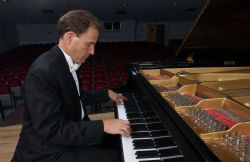|
Symphony
FROM THE NEW WORLD TO THE OLD WORLD
by Peter Lert
Saturday, June 14, 2025
Chamber
MC2 DUO RECITAL CLOSES 222'S SEASON
by Terry McNeill
Saturday, June 14, 2025
Choral and Vocal
CANTIAMO SONOMA'S LUSCIOUS A CAPELLA SINGING IN SEASON ENDING CONCERT
by Pamela Hicks Gailey
Sunday, June 8, 2025
Symphony
SRS SEASON ENDS WITH RESOUNDING TA-TA-TA-BANG
by Terry McNeill
Sunday, June 1, 2025
Symphony
YOUTHFUL VIRTUOSITY ON DISPLAY AT USO'S MAY CONCERTS
by Peter Lert
Saturday, May 17, 2025
Symphony
MYSTICAL PLANETS AND LIVELY GERSHWIN ORTIZ AT FINAL SRS CONCERT
by Peter Lert
Sunday, May 4, 2025
Symphony
VSO'S CONCERT MUSIC OF TIME, MUSIC OF PLACE
by Peter Lert
Sunday, April 27, 2025
VOCAL ELEGANCE AND FIRE AT THE 222'S RECITAL APRIL 26
by Pamela Hicks Gailey
Saturday, April 26, 2025
CANTIAMO SONOMA SINGS AN INSPIRED GOOD FRIDAY MOZART REQUIEM CONCERT
by Pamela Hicks Gailey
Friday, April 18, 2025
DRAMATIC SHOSTAKOVICH SYMPHONY CLOSES PHILHARMONIC'S 25TH SEASON
by Terry McNeill
Sunday, April 13, 2025
|
 |
 Pianist David Korevaar |
KOREVAAR BALANCES THE POPULAR WITH THE UNKNOWN
by Terry McNeill
Friday, March 27, 2009
Pianist David Korevaar brought a curiously unbalanced program to the Santa Rosa Junior College Chamber Series on March 27 for the SRJC seasonís final event. Unbalanced because the first half consisted of essentially unknown works, whereas the second half consisted of Schubertís most popular piano sonata.
Korevaar, who teaches at the University of Colorado, began his recital in the half-full Newman Auditorium with Brahmsís Variations on a Hungarian Song, Op. 21, No. 2. A master of the variation form, Brahms wrote two big Paganini and Handel sets that have challenged pianists since the 1860s, but the variations here are shorter and less inspired. Unlike the Handel Variations, which only begin to sound like Brahms at the second variation, the Hungarian variations bear all the marks of the German master in the very first variation, right after the statement of the theme. Though the variations are not a subtle work, Korevaar played them convincingly, with a strong bass line and careful development of the complex theme.
Erno Von Dohnanyi, a Hungarian virtuoso who ended his career in Florida, composed his Variations on a Hungarian Folk Song in 1916, and there are echoes of Liszt, Brahms and Rubinstein in his 10 variations in classical form. The sound of chimes permeates several variations. Korevaarís reliable octave technique served the digital demands in the ninth variation, and the concluding slow arpeggios of the tenth shimmered with rich colors.
A work probably unknown to the entire audience, Castelnuovo-Tedescoís Piedigrotta (1924), closed the first half. Set out in five widely different movements, played here often without break, Piedigrotta is a Neapolitan rhapsody that makes virtuosic demands but delivers a piquant musical story. Opening with a lively tarantella, the work turns quickly to a nocturnal aria with references to Albenizís Iberia. Korevaar controlled the repeated chord figurations and swift hand crossings with ease, making the whirling and impulsive ďCalasciunateĒ dance section an exciting blur of sound. These pieces, although not dissonant, reflect the harmonic language of impressionism and are close to Griffesís The Fountain of the Aqua Paola. A lovely descending glissando introduces the final movement, where rapid repeated notes and minor seconds generate a giddy, wild ride all over the keyboard. A novel and provocative piece, Piedigrotta was thrillingly rendered by Korevaar to loud applause.
Schubertís last sonata, in B-Flat (D. 960), was written shortly before the composerí death in 1828, and has been a staple of non-Slavic pianists since the acclaim from performances by Schnabel in the 1920s. Itís a long haul, and in Korevaarís reading the four movements lasted just over 45 minutes, with the deep and melancholic opening Molto Moderato running more than 19 minutes alone. Korevaar used the shift pedal continuously in the first two movements, juxtaposing a generally aggressive attack in the dramatic sections with the ethereal and constantly modulating melodies. The big sforzandos had punch, but a jarring break in the deeply felt first-movement texture ó three bars of raucous un-Schubertian chords ó were a mysterious intercession.
The Andante sostenuto was beautifully played, evoking a haunting and certainly religious feeling, the left-hand figures even and at times mesmerizing. The Scherzo, so different than what came before, was played with a light touch and a balance of off-beat accents and cheery frolic. The closing Allegro man non troppo was dramatic and boldly played, more in the style of Serkinís persistence than Alfred Brendelís nobility.
No encores were offered.
All in all, Korevaar performed an estimable recital, ultimately balancing three unfamiliar works with an aristocratic reading of Schubertís sovereign sonata.
|
